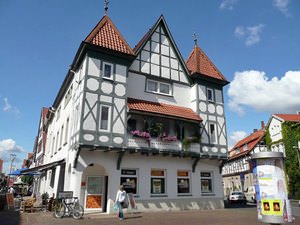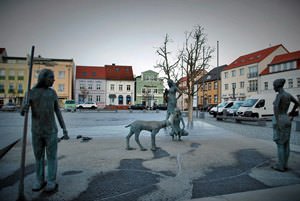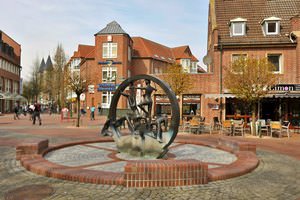
The Federal Republic of Germany is one of the most developed and prosperous countries in the world. Germany covers an area of more than 357 square kilometers. The total population for 2016 was about 85 million people, of which more than a half were economically active. The urbanization of the population is quite high, 87% of the total number of residents live in cities and surrounding areas. Germany is considered to be the leading country in the European Union. Together with France and Great Britain, it forms the unique basis for the European economy. The economic potential in the country is quite high, but the economics is developing more slowly every year. Recently, Germany has taken up the process of establishing integration of world economic ties. At the same time, the country's political influence increased significantly.
1. Despite the high security level in the country, tourists may suffer from pickpockets. Credit cards, money, and documents are best stored in …
Read further
Thanks to the fact that a three-tier budget system operates in Germany, one can clearly follow the development of the economy. The income tax in the country is progressive; it makes from 19 to 45%. VAT for today is 19%. The budget revenues for the past years were, in average, about $1.7 trillion; the country's expenditures are about 1.59 trillion dollars. The public debt of Germany is 61% of GDP. Despite the progressing indicators of the country's overall economy, unemployment has been rising in Germany since the beginning of the 21st century. This is especially evident in the eastern part of the country. This is largely due to the increase in social payments. The GDP per capita for 2010 is $ 37 432.
The infrastructure of the country is at the high level. The roads and railways cover all regions of the country; modern seaports are set in Hamburg and Bremen. Innovative developments and technologies are used in the transport sphere. The agrocomplex is also actively developing. Livestock significantly prevails over plant growing. The reason for this were resource-saving trends, which appeared for the first time back in 1980. The sectoral structure of the entire German economy is based on three main points. Agriculture accounts for less than one percent, and industry makes about 30%. The largest revenue to the country is brought by the services sector; it’s about 69%. Despite this, the very development of the service sector in Germany is slightly lower than in other developed countries. In particular, there are very few jobs in this sphere. On a global scale, Germany provides international financial and banking services. Tourism is well-developed too. Copyright www.orangesmile.com
The Germans are very fond of children and strive to do everything so that they have a nice, colorful and amazing childhood. That is why a huge number …
Read further
The land of Germany does not have a lot of valuable mineral resources. The entire mining industry is concentrated on the extraction of coal and potassium salt. On average, about 200 million tons of coal are mined in German basins per year. At the same time, mines are positioned as unprofitable and exist at the expense of state budget. The oil production in the country is extremely insignificant and does not significantly affect its economic state. The own gas production provides about 30% of the total consumption of raw materials. The largest potash mines are in Saxony and Hesse. Germany's manufacturing industry, to the date, is recognized as one of the leading in the world. A list of industries are considered to be competitive. These are automotive, electrical engineering, transport and general engineering, mechanics and precision optics, ferrous metallurgy, pharmaceutics, cosmetology, and perfumery.
![Ribnitz-Damgarten Ribnitz-Damgarten]()
The basis of Germany's modern economy is engineering. About 42% of the world printing equipment is produced in Germany. Also, 32% of the total market is occupied by German machines for the textile and metallurgical industries, 31% belongs to an equipment for plastic processing, and 22% is for turbines. More than one million people are engaged in electrical engineering while its quality is considered the world's leading. In Munich, the production of Siemens is concentrated. Its annual income is about 110 million dollars. In Stuttgart, the production assets of Robert Bosch company are set, which bring a profit of about 55 million dollars a year.
In Germany, the garland of victory in the number of stores belongs to two of the largest cities - Berlin and Munich. The superior boutiques with …
Read further
The automotive industry is considered to be a real pride of the country. It is Germany that has been for many years in the top three of the world's leading automotive countries. Its volume is inferior only to the production of cars in Japan and the United States. Despite the fact that according to economic indicators in the automotive industry Germany is catching up with China, German cars deserve respect in the world. In Stuttgart, the country's largest automobile company Daimlerchrysler is located. Its annual income is about 200 million dollars. The assets of the world famous company Volkswagen are in Wolfsburg. The annual income of this company is $135 million. BMW is based in Munich; its annual income is slightly less and makes about 65 million dollars.
![]()
The consumer industry has been declining in recent years, due to a decrease in the sales market. The textile area in Germany is the Ruhr region. The main branches of the food industry are winemaking and brewing. At the same time, one third of the output goes for export. Germany ranks second in the world in terms of exports. The basis of the country's imports are oil and natural gas, as well as coal. The main trading partners of the country are the USA, France, and UK. Reliable trade relations are established with the countries of East Asia and Eastern Europe.
The luxury hotels in Germany, deserving attention of the most discerning traveler.
Read further
One of the main economic problems of Germany is an insufficiently flexible labor market. Besides that, Germans do not work enough. On average, a citizen officially works out only 1 449 hours a year. This figure is significantly lower than in the entire EU area. Trade unions in the country are well-developed, which also shows a negative impact on the overall economy. Due to the excessive bureaucratic pressure, the country's economy loses not less than 52 billion euros a year. The eastern lands of Germany make a significant gap in the overall economy. Despite the impressive investment in the development of the territory, they remain unprofitable and depressive. On average, for 15 years the population of the Eastern Lands fell by 12%. An important problem for the country remains an increase in the average age of life and a decrease in the birth rate.
 The Federal Republic of Germany is one of the most developed and prosperous countries in the world. Germany covers an area of more than 357 square kilometers. The total population for 2016 was about 85 million people, of which more than a half were economically active. The urbanization of the population is quite high, 87% of the total number of residents live in cities and surrounding areas. Germany is considered to be the leading country in the European Union. Together with France and Great Britain, it forms the unique basis for the European economy. The economic potential in the country is quite high, but the economics is developing more slowly every year. Recently, Germany has taken up the process of establishing integration of world economic ties. At the same time, the country's political influence increased significantly.
The Federal Republic of Germany is one of the most developed and prosperous countries in the world. Germany covers an area of more than 357 square kilometers. The total population for 2016 was about 85 million people, of which more than a half were economically active. The urbanization of the population is quite high, 87% of the total number of residents live in cities and surrounding areas. Germany is considered to be the leading country in the European Union. Together with France and Great Britain, it forms the unique basis for the European economy. The economic potential in the country is quite high, but the economics is developing more slowly every year. Recently, Germany has taken up the process of establishing integration of world economic ties. At the same time, the country's political influence increased significantly.
 The basis of Germany's modern economy is engineering. About 42% of the world printing equipment is produced in Germany. Also, 32% of the total market is occupied by German machines for the textile and metallurgical industries, 31% belongs to an equipment for plastic processing, and 22% is for turbines. More than one million people are engaged in electrical engineering while its quality is considered the world's leading. In Munich, the production of Siemens is concentrated. Its annual income is about 110 million dollars. In Stuttgart, the production assets of Robert Bosch company are set, which bring a profit of about 55 million dollars a year.
The basis of Germany's modern economy is engineering. About 42% of the world printing equipment is produced in Germany. Also, 32% of the total market is occupied by German machines for the textile and metallurgical industries, 31% belongs to an equipment for plastic processing, and 22% is for turbines. More than one million people are engaged in electrical engineering while its quality is considered the world's leading. In Munich, the production of Siemens is concentrated. Its annual income is about 110 million dollars. In Stuttgart, the production assets of Robert Bosch company are set, which bring a profit of about 55 million dollars a year.
 The consumer industry has been declining in recent years, due to a decrease in the sales market. The textile area in Germany is the Ruhr region. The main branches of the food industry are winemaking and brewing. At the same time, one third of the output goes for export. Germany ranks second in the world in terms of exports. The basis of the country's imports are oil and natural gas, as well as coal. The main trading partners of the country are the USA, France, and UK. Reliable trade relations are established with the countries of East Asia and Eastern Europe.
The consumer industry has been declining in recent years, due to a decrease in the sales market. The textile area in Germany is the Ruhr region. The main branches of the food industry are winemaking and brewing. At the same time, one third of the output goes for export. Germany ranks second in the world in terms of exports. The basis of the country's imports are oil and natural gas, as well as coal. The main trading partners of the country are the USA, France, and UK. Reliable trade relations are established with the countries of East Asia and Eastern Europe.



